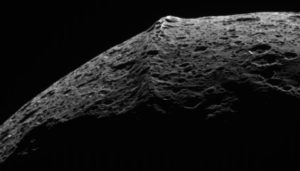Four solar system satellites — and one putative exomoon — might be big enough and far enough from their home worlds to hold onto tiny moons for billions of years.

NASA / JPL-Caltech / Space Science Institute
Moons, planets, and stars seem to follow a clear hierarchy: Moons orbit planets, and planets orbit stars. But now two researchers are asking if a moon can have moons of its own.
If the primary moon is large enough or orbiting far enough from its planet, then a “submoon” could survive in a stable orbit for billions of years, the researchers report October 8th on the astronomy preprint arXiv. What’s more, some of the moons in our own solar system seem to fit the bill.
“I was originally answering a question my son asked me four years ago,” says Juna Kollmeier (Carnegie Observatories), who coauthored the paper with Sean Raymond (University of Bordeaux, France). The mounting evidence for a Neptune-size moon orbiting the Jupiter-size exoplanet Kepler-1625b spurred the researchers to get their ideas out to the community.
The challenge for a submoon is to find an orbit that balances the competing influences of the parent moon and the host planet. A submoon would raise tides on the moon that it orbits, which would feedback to the submoon and change its orbit. A nearby planet complicates matters by gravitationally fiddling with the speed at which the moon rotates, which would also change the orbit of the submoon.
“There’s a Goldilocks zone where you have stable orbits,” Kollmeier explains. “If the submoon gets too close, it will crash into its host moon. If it orbits too far out, it becomes gravitationally unbound.”
Using previous analyses of moons around planets snuggled up to their stars as a starting point, Kollmeier and Raymond calculated how big a moon would need to be to hold on to a roughly 10-kilometer-wide submoon over the age of the solar system, about 4.6 billion years. The results vary — the bigger the moon, for example, the closer it can be to the planet. In a few cases, however, there is a confluence of moon size and orbit in which a submoon could survive.
Four moons in our solar system qualify: Earth’s moon; Jupiter’s moon Callisto; and two of Saturn’s moons, Iapetus and Titan. The bloated satellite of Kepler-1625b might also work, although the researchers note that the apparent high inclination of the moon’s orbit might lead to complications.
The idea that a moon could have a tag-along isn’t all that crazy, says Alex Teachey (Columbia University), who helped build the case for a satellite around Kepler-1625b. “The physics behind calculating the stability of a submoon…is straightforward,” he says. Though he notes that submoons would be impossible to detect in other solar systems for the foreseeable future — even a satellite of a Neptune-size moon would likely be smaller than the dwarf planet Ceres.
“A more interesting question is whether we could detect one of these objects in our solar system, or if there might be some evidence that one of these submoons once existed,” says Teachey. Some researchers have speculated that the 20-kilometer-high ridge that wraps around Saturn’s moon Iapetus might be the remains of a submoon that was torn apart by the satellite’s gravity and then rained down on the surface. “That’s a very intriguing hypothesis.”
References:
J.A. Kollmeier and S.N. Raymond. “Can Moons Have Moons?” arXiv.org. October 8, 2018.
A.J. Dombard et al. "Delayed formation of the equatorial ridge on Iapetus from a subsatellite created in a giant impact." Journal of Geophysical Research: Planets. March 7, 2012.
 0
0
Comments
You must be logged in to post a comment.